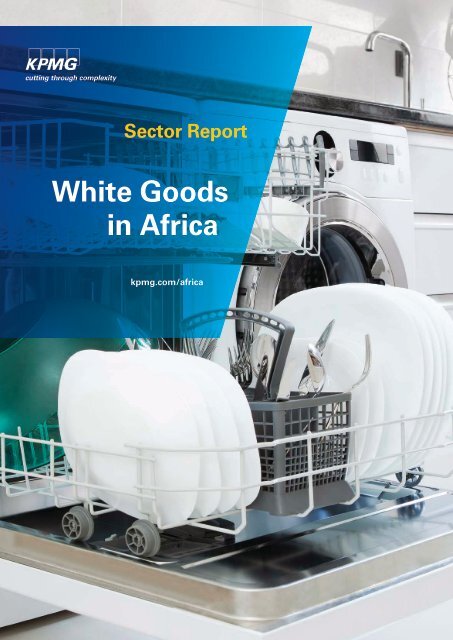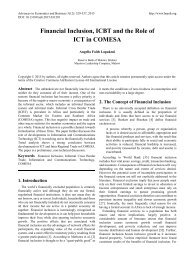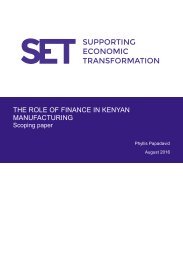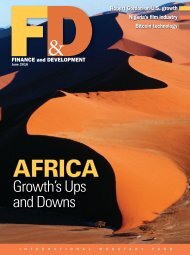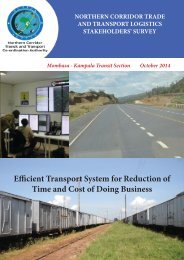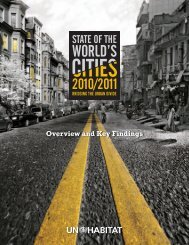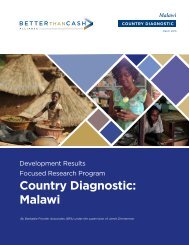White Goods in Africa
VTcO1
VTcO1
Create successful ePaper yourself
Turn your PDF publications into a flip-book with our unique Google optimized e-Paper software.
Sector Report<br />
<strong>White</strong> <strong>Goods</strong><br />
<strong>in</strong> <strong>Africa</strong><br />
kpmg.com/africa
The series has the follow<strong>in</strong>g reports:<br />
• Private Equity <strong>in</strong> <strong>Africa</strong><br />
• Construction <strong>in</strong> <strong>Africa</strong><br />
• Insurance <strong>in</strong> <strong>Africa</strong><br />
• Power <strong>in</strong> <strong>Africa</strong><br />
• Healthcare <strong>in</strong> <strong>Africa</strong><br />
• Bank<strong>in</strong>g <strong>in</strong> <strong>Africa</strong><br />
• Manufactur<strong>in</strong>g <strong>in</strong> <strong>Africa</strong><br />
• Fast-Mov<strong>in</strong>g Consumer <strong>Goods</strong> <strong>in</strong> <strong>Africa</strong><br />
• Luxury <strong>Goods</strong> <strong>in</strong> <strong>Africa</strong><br />
• The <strong>Africa</strong>n Consumer and Retail<br />
• Life Sciences <strong>in</strong> <strong>Africa</strong><br />
• Agriculture <strong>in</strong> <strong>Africa</strong>
Table of Contents<br />
Introduction & Overview 1<br />
Manufactur<strong>in</strong>g & Exports 2<br />
South <strong>Africa</strong> 3<br />
Egypt 4<br />
Tunisia 5<br />
Major Household Appliances: Largest Markets 6<br />
Nigeria 7<br />
Egypt 8<br />
South <strong>Africa</strong> 9<br />
Morocco 10<br />
Ethiopia 11<br />
Kenya 11<br />
Ghana 11<br />
Ivory Coast 13<br />
F<strong>in</strong>al Thoughts 14<br />
Sources of Information 16<br />
Contact Details 17
1 | <strong>White</strong> <strong>Goods</strong> <strong>in</strong> <strong>Africa</strong><br />
Introduction & Overview<br />
<strong>Africa</strong> is currently home to one billion people,<br />
present<strong>in</strong>g a massive potential consumer market.<br />
Furthermore, the cont<strong>in</strong>ent’s population will surpass<br />
the 1.5 billion mark by 2026 and the two billion<br />
mark 15 years later. The strong growth <strong>in</strong> <strong>Africa</strong>n<br />
consumer spend<strong>in</strong>g over the past decade and<br />
the positive outlook for demographic dividends<br />
over the com<strong>in</strong>g decades is part of the consumer<br />
evolution story that is perennially talked about <strong>in</strong><br />
<strong>Africa</strong>n bus<strong>in</strong>ess and <strong>in</strong>vestment circles. <strong>Africa</strong>ns<br />
are <strong>in</strong>creas<strong>in</strong>gly mov<strong>in</strong>g to cities, mak<strong>in</strong>g it easier<br />
for companies to target certa<strong>in</strong> consumer groups.<br />
Admittedly, <strong>Africa</strong>’s retail sector rema<strong>in</strong>s relatively<br />
under-developed at present, with most shopp<strong>in</strong>g<br />
still be<strong>in</strong>g done at traditional shops and markets. The<br />
formalisation of retail activities – already underway –<br />
will be a key trend underly<strong>in</strong>g the sector’s expansion<br />
<strong>in</strong> the com<strong>in</strong>g decade. Another key challenge for<br />
retailers and white goods sellers <strong>in</strong> particular is<br />
the high levels of poverty on the cont<strong>in</strong>ent. Most<br />
of <strong>Africa</strong>’s consumers are extremely poor, and<br />
spend the majority of their money on food and<br />
other necessities – the acquisition of household<br />
furniture and appliances accounts for only around<br />
5% of household expenditure. Nonetheless,<br />
the cont<strong>in</strong>ent’s middle class (those households<br />
spend<strong>in</strong>g more than US$3,000 per annum) totals<br />
almost 40 million.<br />
This report will firstly look at the cont<strong>in</strong>ent’s major<br />
manufacturers and exporters of white goods (South<br />
<strong>Africa</strong> and Egypt, and to a lesser extent Tunisia).<br />
Secondly, based on imports and market size data,<br />
the follow<strong>in</strong>g major white goods markets will be<br />
reviewed: Nigeria, Egypt, South <strong>Africa</strong>, Morocco,<br />
Ethiopia, Kenya, Ghana, and Ivory Coast.
<strong>White</strong> <strong>Goods</strong> <strong>in</strong> <strong>Africa</strong> | 2<br />
Manufactur<strong>in</strong>g & Exports<br />
There are many reasons why <strong>Africa</strong>’s manufactur<strong>in</strong>g<br />
sector is under-developed: limited access to effective<br />
and efficient labour; <strong>in</strong>adequate <strong>in</strong>frastructure; armed<br />
conflict, corruption and <strong>in</strong>stability not be<strong>in</strong>g conducive<br />
to long-term capital <strong>in</strong>vestments; ris<strong>in</strong>g fuel and<br />
electricity prices (and associated issues with reliability<br />
of supply); competition with Asian and developed world<br />
counterparts; a shortage of domestic suppliers of <strong>in</strong>puts;<br />
and the high costs of import<strong>in</strong>g and export<strong>in</strong>g goods,<br />
amongst other issues. Manufactur<strong>in</strong>g exports account<br />
for around a quarter of the cont<strong>in</strong>ent’s export revenues<br />
compared to a figure of 75% for East and South Asia.<br />
Nonetheless, there are more than a handful of countries<br />
on the cont<strong>in</strong>ent that rely on manufactur<strong>in</strong>g for a notable<br />
part of their overall economic activity. These economics<br />
<strong>in</strong>clude (<strong>in</strong> alphabetical order. Algeria (oil ref<strong>in</strong><strong>in</strong>g,<br />
gas and food process<strong>in</strong>g); Angola (oil ref<strong>in</strong><strong>in</strong>g); Egypt<br />
(textiles, cement products and automobiles); Ghana<br />
(alum<strong>in</strong>ium smelt<strong>in</strong>g, cement, and agro-process<strong>in</strong>g);<br />
Kenya (food cann<strong>in</strong>g, gra<strong>in</strong> mill<strong>in</strong>g and sugar ref<strong>in</strong><strong>in</strong>g);<br />
Libya (oil ref<strong>in</strong><strong>in</strong>g, food and fertilisers); Morocco (textiles,<br />
electronic goods and automobiles); Nigeria (oil ref<strong>in</strong><strong>in</strong>g<br />
and cement); South <strong>Africa</strong> (energy and metal products);<br />
Swaziland (textile-related products), Tanzania (food and<br />
beverages); Tunisia (key <strong>in</strong>dustries <strong>in</strong>clude mechanical<br />
and electronic goods, textiles and agro-process<strong>in</strong>g); and<br />
Uganda (agro-process<strong>in</strong>g). There is no <strong>Africa</strong>n country<br />
very dependent on the production of white goods. South<br />
<strong>Africa</strong> and Egypt represented the only two economies<br />
with major excess production of certa<strong>in</strong> white goods and<br />
accounted for 87% of <strong>Africa</strong>’s white goods exports dur<strong>in</strong>g<br />
2011-13. When add<strong>in</strong>g Tunisia, this figure <strong>in</strong>creases to<br />
90%. Namibia and Swaziland comb<strong>in</strong>ed accounted for a<br />
further five percentage po<strong>in</strong>ts of these shipments, while<br />
the addition of Kenya and Morocco sees these seven<br />
economies represent<strong>in</strong>g almost 97% of white goods<br />
exports. Over the past five years, some three-quarters of<br />
these exported goods (by value) were cool<strong>in</strong>g equipment:<br />
refrigerators & freezers and air conditioners. <strong>White</strong><br />
goods exports as calculated <strong>in</strong> this report were valued<br />
at an average of US$470m dur<strong>in</strong>g 2011-13. However,<br />
this represented less than 0.1% of the cont<strong>in</strong>ent’s total<br />
export revenues for the period.
3 | <strong>White</strong> <strong>Goods</strong> <strong>in</strong> <strong>Africa</strong><br />
South <strong>Africa</strong><br />
The South <strong>Africa</strong>n government is keenly focused<br />
on factories and heavy <strong>in</strong>dustry as an employment<br />
creator based on the observed horizontal and<br />
vertical impacts of these <strong>in</strong>dustries on growth and<br />
employment <strong>in</strong> other sectors. <strong>Africa</strong>’s secondlargest<br />
economy is amongst the cont<strong>in</strong>ent’s best<br />
performers (alongside Mauritius, Morocco, Kenta,<br />
Tunisia and Rwanda) when consider<strong>in</strong>g features<br />
such as the quality of overall <strong>in</strong>frastructure, workers’<br />
pay versus productivity, local supplier quantity<br />
and quality, the state of cluster development, and<br />
value cha<strong>in</strong> breadth. Nonetheless, South <strong>Africa</strong>’s<br />
factory sector – and <strong>in</strong> particular those <strong>in</strong>volved <strong>in</strong><br />
<strong>in</strong>termediate technology goods – faces several key<br />
challenges at present: a shortage <strong>in</strong> and the high<br />
cost of skilled labour, constra<strong>in</strong>ts on energy supply,<br />
and competition from Asian companies both <strong>in</strong> the<br />
domestic and <strong>in</strong>ternational market. Calculations<br />
based on data from Statistics South <strong>Africa</strong> (StatsSA)<br />
<strong>in</strong>dicated that household appliances represented<br />
0.75% of the physical volume of factory production<br />
<strong>in</strong> the country dur<strong>in</strong>g 2014 – similar to the level seen<br />
<strong>in</strong> 2011. The country’s kitchen appliance exports<br />
are dom<strong>in</strong>ated by refrigerators and freezers: 70%<br />
of South <strong>Africa</strong>’s white goods shipments dur<strong>in</strong>g<br />
2011-13 came from this category. From a company<br />
perspective, Defy Appliances (part of the Koç Hold<strong>in</strong>g<br />
<strong>in</strong>dustrial conglomerate, a Fortune Global 500<br />
company) is the largest manufacturer and distributor<br />
of major domestic appliances <strong>in</strong> Southern <strong>Africa</strong>, with<br />
factories <strong>in</strong> Durban, Ladysmith and East London – the<br />
latter two facilities be<strong>in</strong>g home to the company’s<br />
refrigerator and freezer production. The company<br />
has agents <strong>in</strong> Botswana, Namibia, Swaziland, Zambia<br />
and Zimbabwe and sells goods under the Defy<br />
and Ocean brands. Hisense South <strong>Africa</strong> produces<br />
consumer electronics and home appliances at its<br />
facility <strong>in</strong> Cape Town (opened dur<strong>in</strong>g June 2013) and<br />
exports these products to Southern <strong>Africa</strong>n countries<br />
as well as Ghana, Liberia and Cameroon. Whirlpool<br />
SA distributes household appliances to the South<br />
<strong>Africa</strong>n market and a selection of other countries on<br />
the cont<strong>in</strong>ent, <strong>in</strong>clud<strong>in</strong>g locally-produced goods under<br />
the KIC brand.<br />
Koç Hold<strong>in</strong>g Chairman Mustafa Koç said dur<strong>in</strong>g<br />
November 2014 that he would like to see South<br />
<strong>Africa</strong> be established as a white goods export hub<br />
much as the country is seen as an automotive hub.<br />
Follow<strong>in</strong>g his company’s US$324m acquisition<br />
of Defy dur<strong>in</strong>g 2011, reported to be the largest<br />
<strong>in</strong>vestment ever by a Turkish company <strong>in</strong>to <strong>Africa</strong>,<br />
Koç Hold<strong>in</strong>g set <strong>in</strong> motion plans to upgrade the<br />
South <strong>Africa</strong>n manufacturer’s facilities <strong>in</strong> order<br />
to <strong>in</strong>crease its exports <strong>in</strong>to sub-Saharan <strong>Africa</strong>n<br />
(SSA) markets. Accord<strong>in</strong>g to Eng<strong>in</strong>eer<strong>in</strong>g News,<br />
renovation of the Jacobs facility <strong>in</strong> Durban (key<br />
products <strong>in</strong>clude stoves, build-<strong>in</strong> ovens and air<br />
conditioners) and the establishment of two more<br />
production l<strong>in</strong>es at the Ezakheni facility <strong>in</strong> Ladysmith<br />
(key products <strong>in</strong>clude refrigerators and freezers)<br />
was completed with<strong>in</strong> the first two years after<br />
the buyout. A three-year, US$50m expansion plan<br />
raised Defy’s output by more than 30% and <strong>in</strong>cluded<br />
technology transfer from Turkey. This, accord<strong>in</strong>g<br />
to South <strong>Africa</strong>n trade and <strong>in</strong>dustry m<strong>in</strong>ister, Rob<br />
Davies, is <strong>in</strong> l<strong>in</strong>e with the country’s Industrial<br />
Policy Action Plan (Ipap). Mr Davies sees the white<br />
goods <strong>in</strong>dustry as “strategic” for the country’s<br />
manufactur<strong>in</strong>g sector: “Hence we developed<br />
a white goods strategy with key <strong>in</strong>terventions<br />
of upgrad<strong>in</strong>g the technology and meet<strong>in</strong>g the<br />
environmental imperatives,” said the m<strong>in</strong>ister.
<strong>White</strong> <strong>Goods</strong> <strong>in</strong> <strong>Africa</strong> | 4<br />
Egypt<br />
The local factory sector struggled dur<strong>in</strong>g 2011-12<br />
as political and labour unrest made it impossible<br />
for many factories to work at full capacity while<br />
many others were closed down. The situation<br />
looked somewhat better <strong>in</strong> 2013, though on-go<strong>in</strong>g<br />
protests, a shortage of foreign currency (at times),<br />
as well as a cut <strong>in</strong> state energy subsidies to some<br />
<strong>in</strong>dustries weighed on production. Dur<strong>in</strong>g 2014, the<br />
manufactur<strong>in</strong>g <strong>in</strong>dustry rebounded strongly as the<br />
security situation improved and as billions of dollars’<br />
worth of aid from Gulf Cooperation Council (GCC)<br />
countries eased the country’s foreign-exchange<br />
shortages. Dur<strong>in</strong>g the 2011-14 period, around<br />
three-quarters of Egypt’s manufactured goods were<br />
exported to Europe, while white goods were mostly<br />
sold to countries <strong>in</strong> the Middle East and elsewhere<br />
<strong>in</strong> North <strong>Africa</strong>. Almost 55% of white goods are<br />
classified as stoves, ovens & grills: the value of<br />
these exports <strong>in</strong>creased by an average of more than<br />
20% p.a. dur<strong>in</strong>g 2010-12 <strong>in</strong> spite of the country’s<br />
political situation. Data from the Central Bank of<br />
Egypt (CBE) <strong>in</strong>dicates that the country produced<br />
nearly 1.2 million wash<strong>in</strong>g mach<strong>in</strong>es and the same<br />
volume of refrigerators dur<strong>in</strong>g the 2011/12 (July<br />
– June) f<strong>in</strong>ancial year – this is the latest available<br />
data. Unit output of these two categories of goods<br />
<strong>in</strong>creased by an average of 4.2% p.a. dur<strong>in</strong>g the<br />
2002/03 – 2011/12 period, and by a mean of 4.7%<br />
p.a. when exclud<strong>in</strong>g the troubled 2010/11 period.<br />
While exports are important to the local <strong>in</strong>dustry,<br />
a great number of these units were dest<strong>in</strong>ed for<br />
the domestic market. The Kiriazi Group considers<br />
itself “the most important group of companies<br />
produc<strong>in</strong>g home appliances <strong>in</strong> Egypt and <strong>in</strong> the Arab<br />
World,” with five factories produc<strong>in</strong>g refrigerators<br />
and freezers, wash<strong>in</strong>g mach<strong>in</strong>es, and gas cookers.<br />
Four of these factories are situated <strong>in</strong> Obour City<br />
(35 km north-east of Cairo). In turn, global appliance<br />
manufacturer Electrolux referred to the Olympic<br />
Group as Egypt’s “lead<strong>in</strong>g appliance manufacturer”<br />
dur<strong>in</strong>g 2011 <strong>in</strong> documentation relat<strong>in</strong>g to the<br />
acquisition of the Egyptian company. The Olympic<br />
Group sells refrigerators, laundry wash<strong>in</strong>g mach<strong>in</strong>es,<br />
ovens, microwaves and other products, of which<br />
98% are manufactured by the organisation. The<br />
company’s wholly-owned wholesale trader EPA is<br />
the largest white goods trader <strong>in</strong> Egypt.
5 | <strong>White</strong> <strong>Goods</strong> <strong>in</strong> <strong>Africa</strong><br />
Tunisia<br />
The manufactur<strong>in</strong>g sector (account<strong>in</strong>g for 16% of<br />
GDP dur<strong>in</strong>g 2014) rema<strong>in</strong>s of critical importance to<br />
the Tunisian economy, and factory goods produced<br />
are ma<strong>in</strong>ly aimed at export<strong>in</strong>g to European markets.<br />
The sector’s growth over the past decade has<br />
ma<strong>in</strong>ly been driven by the mechanical and electrical<br />
equipment <strong>in</strong>dustry: the ma<strong>in</strong> exports <strong>in</strong> the<br />
mechanical & electrical <strong>in</strong>dustry are wir<strong>in</strong>g, cables<br />
and cable harnesses; electrical command apparatus;<br />
transformers; pr<strong>in</strong>ted circuits; and refrigerators.<br />
Accord<strong>in</strong>g to the Foreign Investment Promotion<br />
Agency (FIPA), there were 824 companies focused<br />
on mechanical and metallurgical production dur<strong>in</strong>g<br />
2014 and 454 companies associated with electrical<br />
& electronic <strong>in</strong>dustries (<strong>in</strong>clud<strong>in</strong>g household<br />
appliances). Around a third of these enterprises are<br />
fully export oriented. Trade Map data <strong>in</strong>dicates that<br />
the country’s exports of major kitchen appliances<br />
averaged US$18m p.a. dur<strong>in</strong>g 2002-08 followed<br />
by a negative trend <strong>in</strong> the follow<strong>in</strong>g three years (<strong>in</strong><br />
the aftermath of the global f<strong>in</strong>ancial crisis) to just<br />
US$10m dur<strong>in</strong>g 2011. Export values similar to the<br />
pre-2009 period were aga<strong>in</strong> seen dur<strong>in</strong>g 2012-13.<br />
From a GDP perspective, the World Bank estimates<br />
that the manufactur<strong>in</strong>g sector contracted by 1.4%<br />
dur<strong>in</strong>g 2009 (l<strong>in</strong>ked to the global f<strong>in</strong>ancial crisis), and<br />
aga<strong>in</strong> by 2.4% <strong>in</strong> 2011 (at the time of the Arab Spr<strong>in</strong>g).<br />
Ch<strong>in</strong>a’s Haier Group – the world’s largest maker of<br />
white goods – has a production site some 40 km from<br />
the capital city of Tunis and produces refrigerators,<br />
freezers, laundry wash<strong>in</strong>g mach<strong>in</strong>es, dish wash<strong>in</strong>g<br />
mach<strong>in</strong>es, microwave ovens, and other appliances<br />
for the domestic as well as export market.
<strong>White</strong> <strong>Goods</strong> <strong>in</strong> <strong>Africa</strong> | 6<br />
Major Household Appliances: Largest Markets<br />
cost of delivery and <strong>in</strong>stallation of the appliances when<br />
applicable. Comb<strong>in</strong>ed by household size data from<br />
the ICF International, USAID and Euromonitor World<br />
Factbook 2014 as well as population data from the<br />
United Nations, this has allowed for the calculation of<br />
the market size for major appliances <strong>in</strong> <strong>Africa</strong>n countries.<br />
Admittedly, the World Bank’s estimates of usage are not<br />
complete, and exclude major economies such as Algeria<br />
and Angola. As a result, the calculated total market size<br />
of nearly US$40bn dur<strong>in</strong>g 2010 for 35 <strong>Africa</strong>n countries<br />
should be seen as a m<strong>in</strong>imum value. Nigeria offered the<br />
largest market at US$18.7bn followed by South <strong>Africa</strong> at<br />
US$13.7bn.<br />
Based on country-specific survey/census data, the<br />
World Bank offers <strong>in</strong>formation on the household usage<br />
(measured <strong>in</strong> US dollar) of major appliances dur<strong>in</strong>g 2010<br />
(latest available data). This <strong>in</strong>cludes the five white goods<br />
categories identified <strong>in</strong> the preced<strong>in</strong>g text/graphs as well<br />
as laundry dryers; dry<strong>in</strong>g cab<strong>in</strong>ets; iron<strong>in</strong>g and press<strong>in</strong>g<br />
mach<strong>in</strong>es; humidifiers; heaters; ventilators and extractor<br />
hoods; vacuum cleaners; steam-clean<strong>in</strong>g mach<strong>in</strong>es;<br />
carpet clean<strong>in</strong>g mach<strong>in</strong>es; mach<strong>in</strong>es for scrubb<strong>in</strong>g,<br />
wax<strong>in</strong>g and polish<strong>in</strong>g floors; safes; sew<strong>in</strong>g mach<strong>in</strong>es;<br />
and knitt<strong>in</strong>g mach<strong>in</strong>es. The estimate also <strong>in</strong>cludes the<br />
Regard<strong>in</strong>g imports, more than 70% of the cont<strong>in</strong>ent’s<br />
white goods imports over the past five years have been<br />
cool<strong>in</strong>g equipment – refrigerators & freezers and air<br />
conditioners. Clean<strong>in</strong>g appliances (laundry and dish<br />
wash<strong>in</strong>g mach<strong>in</strong>es) represented almost 15% of imports<br />
while cook<strong>in</strong>g and heat<strong>in</strong>g equipment (stoves, ovens<br />
& grills and microwave ovens) accounted for 13% of<br />
imports. Eight countries – Algeria, Egypt, South <strong>Africa</strong>,<br />
Nigeria, Morocco, Angola, Tunisia and Ghana, listed<br />
by the value of their 2013 imports of white goods –<br />
accounted for three-quarters of <strong>Africa</strong>’s white goods<br />
imports. Algeria is now the largest market for white<br />
goods imports.
7 | <strong>White</strong> <strong>Goods</strong> <strong>in</strong> <strong>Africa</strong><br />
Nigeria<br />
<strong>Africa</strong>’s largest economy accounts for a fifth of<br />
the cont<strong>in</strong>ent’s total population and has a very<br />
high potential for large demographic dividend. It is<br />
therefore not surpris<strong>in</strong>g to learn that the country<br />
received US$1.3bn worth of <strong>in</strong>vestment <strong>in</strong> its<br />
retail sector dur<strong>in</strong>g 2012-13, with retail activity<br />
represent<strong>in</strong>g 16.4% of GDP dur<strong>in</strong>g 2014. And<br />
even though only a small proportion of Nigeria’s<br />
population can as yet afford luxury products, this is<br />
not an <strong>in</strong>significant number of people <strong>in</strong> absolute<br />
terms. The country has almost a million citizens<br />
classified as middle class and almost 17,500 citizens<br />
with <strong>in</strong>vestible assets of at least US$1m. Research<br />
by Renaissance Capital <strong>in</strong>dicates that 87% of<br />
middle class households have a refrigerator and<br />
four out of 10 have a comb<strong>in</strong>ation refrigerator and<br />
freezer appliance. The consumer story <strong>in</strong> Nigeria is<br />
underp<strong>in</strong>ned by many factors, <strong>in</strong>clud<strong>in</strong>g a large and<br />
ris<strong>in</strong>g population, an <strong>in</strong>creased rate of urbanisation<br />
(currently around 50%), grow<strong>in</strong>g sophistication of<br />
the retail market, and a burgeon<strong>in</strong>g e-commerce<br />
trend, amongst other factors. A recent improvement<br />
<strong>in</strong> the prospects of the country’s electricity situation<br />
is also a positive aspect <strong>in</strong> the outlook for white<br />
goods sales. As part of a privatisation exercise,<br />
the Nigerian electricity <strong>in</strong>dustry was unbundled<br />
<strong>in</strong>to generation and distribution companies and<br />
a s<strong>in</strong>gle transmission company. Accord<strong>in</strong>g to the<br />
local statistics agency, Nigerian households already<br />
spend around 5% of their budget on household<br />
furniture and appliances. These Nigerians played a<br />
role <strong>in</strong> <strong>in</strong>creas<strong>in</strong>g the country’s white goods imports<br />
from around US$300m p.a. dur<strong>in</strong>g 2008-09 to almost<br />
US$600m by 2011, followed by an import bill of<br />
US$400m p.a. dur<strong>in</strong>g 2012-13. Cool<strong>in</strong>g equipment<br />
– refrigerators & freezers and air conditioners –<br />
accounted for more than three-quarters of white<br />
goods imports dur<strong>in</strong>g 2011-13. Ch<strong>in</strong>ese companies<br />
are the premier suppliers of these appliances.
<strong>White</strong> <strong>Goods</strong> <strong>in</strong> <strong>Africa</strong> | 8<br />
Egypt<br />
As the cont<strong>in</strong>ent’s third-largest economy (ahead of<br />
Algeria), it is not surpris<strong>in</strong>g that Egypt has <strong>in</strong> recent<br />
years also been amongst the top three importers<br />
of white goods. In fact, the value of these imports<br />
surpassed that of South <strong>Africa</strong> dur<strong>in</strong>g 2013 to place<br />
Egypt second on the cont<strong>in</strong>ent after Algeria – the<br />
latter has seen its white goods imports double<br />
from 2009 to 2013. A big factor <strong>in</strong> the country’s<br />
overall import appetite for major appliances is its<br />
large population of more than 83 million as well<br />
as a large tourism market that welcomed almost<br />
10 million <strong>in</strong>ternational tourists dur<strong>in</strong>g 2014. In<br />
addition, based on population growth, the pace<br />
of urbanisation and the chang<strong>in</strong>g landscape of<br />
the median <strong>Africa</strong>n age structure, Egypt has a<br />
significant demographic potential – i.e. strong<br />
growth prospects for consumer spend<strong>in</strong>g due to<br />
demographically favourable developments. Already,<br />
if five of Egypt’s governorates that make up most<br />
of the desert area are excluded from consideration,<br />
the rema<strong>in</strong>der of the country is one of the most<br />
densely populated regions <strong>in</strong> the world. Given this<br />
exceptionally high concentration of people, retail and<br />
other consumer-related <strong>in</strong>vestment opportunities<br />
along the Nile are immense. In this regard, the<br />
country is also seen as amongst the best prospects<br />
for expansion <strong>in</strong> the demand for luxury goods, e.g.<br />
products and services not essential to basic needs.<br />
The country’s domestic market for major appliances<br />
was already valued at US$2.3bn dur<strong>in</strong>g 2010 and<br />
white goods imports have s<strong>in</strong>ce then <strong>in</strong>creased by<br />
at least 50%. (Key suppliers of Egypt’s white goods<br />
imports <strong>in</strong>clude Ch<strong>in</strong>a, Italy, Thailand, Indonesia,<br />
Malaysia, South Korea, and Turkey.) Admittedly,<br />
there are some negative aspects to consider,<br />
<strong>in</strong>clud<strong>in</strong>g ongo<strong>in</strong>g political uncerta<strong>in</strong>ty, the relatively<br />
small percentage of household spend<strong>in</strong>g towards<br />
furniture and appliances compared to other <strong>Africa</strong>n<br />
economies, as well as the cont<strong>in</strong>ued struggle of<br />
western style shopp<strong>in</strong>g malls to fill their vacant<br />
spaces. Traditionally, Egypt is a nation of street<br />
retailers, with most Egyptians shopp<strong>in</strong>g <strong>in</strong> local<br />
neighbourhoods and at classic souks such as Cairo’s<br />
Khan el-Khalili.
9 | <strong>White</strong> <strong>Goods</strong> <strong>in</strong> <strong>Africa</strong><br />
South <strong>Africa</strong><br />
A grow<strong>in</strong>g middle class, expand<strong>in</strong>g tourism and<br />
hospitality sectors, and a well-developed retail sector<br />
translate <strong>in</strong>to <strong>Africa</strong>’s most advanced economy be<strong>in</strong>g<br />
the largest importer of white goods dur<strong>in</strong>g 2011-13,<br />
purchas<strong>in</strong>g an annual average of US$630m of these<br />
goods. This is <strong>in</strong> addition to the prevalence of locally<br />
manufactured goods (discussed above). In particular,<br />
the country was the largest buyer on the cont<strong>in</strong>ent of<br />
refrigerators & freezers and dish wash<strong>in</strong>g mach<strong>in</strong>es<br />
as well as the second-largest buyer of stoves,<br />
ovens & grills and laundry wash<strong>in</strong>g mach<strong>in</strong>es. Local<br />
manufactur<strong>in</strong>g capacity for white goods is unable to<br />
satisfy the Ra<strong>in</strong>bow Nation’s demand for electrical<br />
appliances, and Asian countries such as Ch<strong>in</strong>a, South<br />
Korea and Malaysia help satisfy South <strong>Africa</strong>’s import<br />
requirements. However, the developed nature of<br />
South <strong>Africa</strong>’s white goods market translates <strong>in</strong>to<br />
slower growth <strong>in</strong> this sector than seen elsewhere<br />
on the cont<strong>in</strong>ent. The country has for a long time had<br />
a substantial middle class, with one <strong>in</strong> three of its<br />
citizens currently classified as receiv<strong>in</strong>g an <strong>in</strong>come<br />
equal to or higher than the World Bank’s classification<br />
of middle class. In fact, South <strong>Africa</strong>’s middle class<br />
accounts for almost half of the cont<strong>in</strong>ent’s middle<br />
class, and is four times larger than the comb<strong>in</strong>ed<br />
middle classes of the East <strong>Africa</strong>n Community (EAC)<br />
countries. Not surpris<strong>in</strong>gly for such a large consumer<br />
base, StatsSA’s census survey dur<strong>in</strong>g 2011 showed<br />
that two out of three South <strong>Africa</strong>n households have a<br />
refrigerator. The country’s retail sales of white goods<br />
is buttressed by an advanced shopp<strong>in</strong>g <strong>in</strong>frastructure<br />
rang<strong>in</strong>g from small speciality stalls to shopp<strong>in</strong>g malls<br />
rivall<strong>in</strong>g European facilities <strong>in</strong> size and quality. Sales<br />
of household furniture, appliances and equipment<br />
account for only about 5% of South <strong>Africa</strong>’s retail<br />
sales though act as a strong <strong>in</strong>dicator of consumer<br />
sentiment <strong>in</strong> the country. Indeed, a consumer<br />
confidence <strong>in</strong>dex compiled for South <strong>Africa</strong> by First<br />
National Bank (FNB) and the Bureau for Economic<br />
Research (BER) asks respondents to rate (at the<br />
time of the quarterly survey) the appropriateness of<br />
the present time to purchase durable goods such<br />
as furniture, appliances and electronic equipment.<br />
The other two questions asked are focused on 1) the<br />
expected performance of local economy and 2) the<br />
expected f<strong>in</strong>ancial position of households.
<strong>White</strong> <strong>Goods</strong> <strong>in</strong> <strong>Africa</strong> | 10<br />
Morocco<br />
Corner stores have <strong>in</strong> the past dom<strong>in</strong>ated<br />
Morocco’s retail experience due to the number of<br />
cars per capita be<strong>in</strong>g relatively low. However, the<br />
country’s consumption landscape is <strong>in</strong> the process<br />
of chang<strong>in</strong>g from one <strong>in</strong> which <strong>in</strong>formal trad<strong>in</strong>g<br />
(markets and corner shops) dom<strong>in</strong>ate, to one <strong>in</strong><br />
which cha<strong>in</strong>s of supermarkets and hypermarkets<br />
account for a significant portion of consumption.<br />
Onl<strong>in</strong>e retail<strong>in</strong>g is also on the rise on the back of<br />
greater <strong>in</strong>ternet connectivity and a higher number of<br />
<strong>in</strong>dividuals who have access to electronic bank<strong>in</strong>g.<br />
Both the formalisation of retail and a grow<strong>in</strong>g onl<strong>in</strong>e<br />
market are good news for appliance sales. The<br />
government’s Plan Rawaj 2020 (‘rawaj’ means<br />
‘turnover’ <strong>in</strong> a general sense) set the goals of<br />
<strong>in</strong>creas<strong>in</strong>g the retail sector’s contribution to GDP to<br />
15% as well as the creation of 450,000 jobs <strong>in</strong> the<br />
sector. S<strong>in</strong>ce, 2011, four shopp<strong>in</strong>g malls have been<br />
constructed under the plan. Large local grocery<br />
cha<strong>in</strong>s have also ventured <strong>in</strong>to second- and thirdtier<br />
cities with success. The household market for<br />
large appliances is estimated to have been worth<br />
US$1.7bn dur<strong>in</strong>g 2010; Morocco’s white goods<br />
imports were valued at US$340m dur<strong>in</strong>g that year<br />
and <strong>in</strong>creased to nearly US$380m dur<strong>in</strong>g 2013.<br />
Another positive <strong>in</strong>fluence on the sale of large<br />
household appliances is the tourism sector: tourist<br />
arrivals are expected to rise above 11 million dur<strong>in</strong>g<br />
2016. Urbanisation is also a factor to consider: the<br />
United Nations believes that some 18.65 million<br />
Moroccans lived <strong>in</strong> urban areas dur<strong>in</strong>g 2012 (57.4%<br />
of the country’s 32.5 million citizens).
11 | <strong>White</strong> <strong>Goods</strong> <strong>in</strong> <strong>Africa</strong><br />
Ethiopia<br />
The value of the country’s real household expenditure<br />
<strong>in</strong>creased by an average of more than 10% p.a. over<br />
the past decade, and Ethiopia is amongst <strong>Africa</strong>’s<br />
top prospects for consumer spend<strong>in</strong>g growth over<br />
the next five to 10 years. A key feature <strong>in</strong> Ethiopia’s<br />
strong expansion is demographic features: there will<br />
be more than 100 million Ethiopians by 2016 after<br />
average population growth of 2.65% p.a. over the<br />
preced<strong>in</strong>g decade. In addition, nearly 5% (i.e. four<br />
million) of the country’s <strong>in</strong>habitants are currently<br />
considered middle class. From an <strong>in</strong>vestment<br />
perspective, there have been some <strong>in</strong>dications<br />
that the government is cautiously consider<strong>in</strong>g the<br />
steady liberalisation of some sectors, most notably<br />
wholesale and retail trade and some f<strong>in</strong>ancial<br />
services, which is sure to attract foreign <strong>in</strong>terest.<br />
Ethiopia’s imports of white goods (valued at around<br />
US$50m p.a. dur<strong>in</strong>g 2012-13) are dom<strong>in</strong>ated by<br />
refrigerators and freezers, account<strong>in</strong>g for 80%<br />
of offshore purchases <strong>in</strong> this trade category. The<br />
US$50m figure is small though not too surpris<strong>in</strong>g<br />
<strong>in</strong> the context of the country’s relatively underdeveloped<br />
retail sector.<br />
Kenya<br />
Urban areas <strong>in</strong> Kenya have experienced a grow<strong>in</strong>g<br />
middle class, while the country’s retail sector is<br />
already more advanced than that of countries like<br />
Angola and Ghana. Admittedly, private consumption<br />
expenditure <strong>in</strong> the country is very dependent on<br />
agricultural earn<strong>in</strong>gs. The East <strong>Africa</strong>n country’s<br />
grocery retail sector is certa<strong>in</strong>ly larger than its nongrocery<br />
<strong>in</strong>dustry, but the latter (which <strong>in</strong>cludes white<br />
goods) has generally expanded at a faster pace<br />
over the past five years. Kenya was the fifth-largest<br />
importer of microwave ovens on the cont<strong>in</strong>ent dur<strong>in</strong>g<br />
2011-13. The value of the East <strong>Africa</strong>n country’s<br />
white goods imports <strong>in</strong>creased by an average of 20%<br />
p.a. over the past decade to nearly US$75m dur<strong>in</strong>g<br />
2013. Dur<strong>in</strong>g the 2011-13 period, around two-thirds<br />
of kitchen appliance imports <strong>in</strong>to the country were<br />
classified as refrigerators and freezers. Admittedly, a<br />
notable component of these goods would have been<br />
purchases for commercial usage <strong>in</strong> the agricultural,<br />
horticultural and fisheries <strong>in</strong>dustries.<br />
Ghana<br />
Accord<strong>in</strong>g to World Bank data, the average Ghanaian<br />
household spent almost US$145 on major appliances<br />
dur<strong>in</strong>g 2010. This figure translates <strong>in</strong>to a total market<br />
size of approximately US$950m for major household<br />
appliances dur<strong>in</strong>g that year. The country’s modern<br />
retail sector is for now restricted to the capital<br />
and the size of the middle class is still small, albeit<br />
grow<strong>in</strong>g at a rapid pace. Accra is one of the most<br />
modern cities on the cont<strong>in</strong>ent and is experienc<strong>in</strong>g<br />
a period of rapid growth, and is also a ris<strong>in</strong>g star as<br />
measured by the <strong>in</strong>crease <strong>in</strong> US dollar millionaires.<br />
The value of Ghana’s white goods imports <strong>in</strong>creased<br />
by an average of 25% p.a. dur<strong>in</strong>g 2010-13 and<br />
cool<strong>in</strong>g equipment – refrigerators & freezers and<br />
air conditioners – accounted for 85% of these<br />
purchases. This is reflective of household demand as<br />
well as buy<strong>in</strong>g by the hospitality <strong>in</strong>dustry – tourism<br />
employs 115,000 people <strong>in</strong> the country.
13 | <strong>White</strong> <strong>Goods</strong> <strong>in</strong> <strong>Africa</strong><br />
Ivory Coast<br />
Some 65% of Ivory Coast’s white goods imports<br />
are refrigerators and freezers. While it would be<br />
easy to argue that many of these appliances are<br />
dest<strong>in</strong>ed for the fisheries and tourisms sectors, it<br />
is more <strong>in</strong>sightful to consider the country’s corps<br />
of consumers: around 1.6 million of Ivory Coast’s<br />
citizens are classified as middle class. In terms<br />
of wealthy <strong>in</strong>dividuals with money to spend on<br />
luxury appliances, the country recorded a 30% p.a.<br />
<strong>in</strong>crease <strong>in</strong> the number of US dollar millionaires<br />
dur<strong>in</strong>g 2007-13. Ivory Coast’s premier suppliers of<br />
white goods imports are Ch<strong>in</strong>a and former colonial<br />
ruler France. The average Ivorian household spent<br />
US$135 on major household appliances dur<strong>in</strong>g 2010.
<strong>White</strong> <strong>Goods</strong> <strong>in</strong> <strong>Africa</strong> | 14<br />
F<strong>in</strong>al Thoughts<br />
South <strong>Africa</strong> and Egypt will rema<strong>in</strong> the cont<strong>in</strong>ent’s<br />
dom<strong>in</strong>ant manufacturers and exporters of white goods<br />
for many years to come. They also represent some of<br />
the largest markets for white goods sales alongside<br />
other economic heavyweights like Nigeria and Morocco.<br />
There are no big surprises <strong>in</strong> list<strong>in</strong>g <strong>Africa</strong>’s key<br />
producers and buyers (importers) of major appliances<br />
consider<strong>in</strong>g that the goods <strong>in</strong> question are high up on<br />
the expenditure scale – <strong>Africa</strong>ns spend only 5% of their<br />
<strong>in</strong>come on furniture and appliances. Nonetheless, the<br />
market is grow<strong>in</strong>g. The compound annual growth rate<br />
of <strong>Africa</strong>’s imports of white goods was 13% dur<strong>in</strong>g<br />
2010-13 compared to the cont<strong>in</strong>ent’s overall import bill<br />
ris<strong>in</strong>g by a slower 10%. The story of the ris<strong>in</strong>g <strong>Africa</strong>n<br />
consumer is expand<strong>in</strong>g every day and white goods<br />
cannot be excluded from this narrative. Refrigerators<br />
& freezers will rema<strong>in</strong> the dom<strong>in</strong>ant narrative over the<br />
long term and the fastest grow<strong>in</strong>g segment over the<br />
medium term is expected to be air conditioners. The<br />
ma<strong>in</strong> drivers for fast growth <strong>in</strong> cool<strong>in</strong>g, cook<strong>in</strong>g and<br />
clean<strong>in</strong>g equipment is <strong>Africa</strong>’s grow<strong>in</strong>g middle class,<br />
ris<strong>in</strong>g urbanisation rates, <strong>in</strong>creas<strong>in</strong>g electricity supply,<br />
as well as healthy tourism sectors. In our view, the key<br />
markets from an import perspective <strong>in</strong> terms of size are<br />
Nigeria, South <strong>Africa</strong>, Egypt, Morocco, Ethiopia, Kenya,<br />
Ghana, and the Ivory Coast. Admittedly, cont<strong>in</strong>ent-wide<br />
obstacles rema<strong>in</strong>, such as low levels of household<br />
wealth outside the cont<strong>in</strong>ent’s largest economies as well<br />
as underdeveloped retail landscapes outside major cities.<br />
But the scenario is chang<strong>in</strong>g, as is evident from rapid<br />
growth <strong>in</strong> the value of imported white goods over the<br />
past decade.
15 | <strong>White</strong> <strong>Goods</strong> <strong>in</strong> <strong>Africa</strong>
<strong>White</strong> <strong>Goods</strong> <strong>in</strong> <strong>Africa</strong> | 16<br />
Sources of Information<br />
<strong>Africa</strong>n Development Bank (AfDB)<br />
Bureau for Economic Research (BER)<br />
Central Bank of Egypt (CBE)<br />
Egyptian General Authority for Investment (GAFI)<br />
Energy Information Adm<strong>in</strong>istration (EIA)<br />
Eng<strong>in</strong>eer<strong>in</strong>g News<br />
Euromonitor<br />
Foreign Investment Promotion Agency (FIPA)<br />
Gulf Cooperation Council (GCC)<br />
ICF International<br />
International Monetary Fund (IMF)<br />
Kiriazi Group<br />
New World Wealth<br />
NKC <strong>Africa</strong>n Economics<br />
Renaissance Capital<br />
Statistics South <strong>Africa</strong> (StatsSA)<br />
TGI Global<br />
Trade Map<br />
Tunisia’s Foreign Investment Promotion Agency (FIPA)United Nations<br />
United Nations Conference on Trade and Development (UNCTAD)<br />
USAID<br />
US Energy Information Adm<strong>in</strong>istration<br />
World Bank<br />
World Economic Forum (WEF)
17 | <strong>White</strong> <strong>Goods</strong> <strong>in</strong> <strong>Africa</strong><br />
Contact details<br />
KPMG <strong>Africa</strong><br />
Seyi Bickersteth<br />
Chairman KPMG <strong>Africa</strong><br />
T: +23412805984<br />
E: seyi.bickersteth@ng.kpmg.com<br />
Bryan Leith<br />
COO KPMG <strong>Africa</strong><br />
T: +27116476245<br />
E: bryan.leith@kpmg.co.za<br />
Benson Mwesigwa<br />
<strong>Africa</strong> High Growth Markets<br />
KPMG <strong>Africa</strong><br />
T: +27609621364<br />
E: benson.mwesigwa@kpmg.co.za<br />
Molabowale Adeyemo<br />
<strong>Africa</strong> High Growth Markets<br />
KPMG <strong>Africa</strong><br />
T: +27714417378<br />
E: molabowale.adeyemo@kpmg.co.za<br />
Wole Obayomi<br />
Partner, Consumer markets<br />
West <strong>Africa</strong><br />
T: +23412718932<br />
E: wole.obayomi@ng.kpmg.com<br />
Dean Wallace<br />
Partner, Consumer markets<br />
South <strong>Africa</strong><br />
T: +27116476960<br />
E: dean.wallace@kpmg.co.za<br />
Mohs<strong>in</strong> Begg<br />
Manager, Consumer markets<br />
South <strong>Africa</strong><br />
T: +27827186841<br />
E: mohs<strong>in</strong>.begg@kpmg.co.za<br />
Jacob Gathecha<br />
Partner, Consumer markets<br />
East <strong>Africa</strong><br />
T: +254202806000<br />
E: jgathecha@kpmg.co.ke<br />
Fernando Mascarenhas<br />
Partner, Consumer markets<br />
Angola<br />
T: +244227280102<br />
E: femascarenhas@kpmg.com<br />
kpmg.com/social media<br />
kpmg.com/app<br />
© 2015 KPMG <strong>Africa</strong> Limited, a Cayman Islands company and a member firm of the KPMG<br />
network of <strong>in</strong>dependent member firms affiliated with KPMG International Cooperative (“KPMG<br />
International”), a Swiss entity. All rights reserved. The KPMG name, logo and “cutt<strong>in</strong>g through<br />
complexity” are registered trademarks or trademarks of KPMG International. MC13743.


